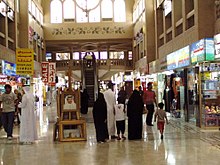Sharjah
![]()
This article explains the city. For the emirate, see Sharjah (emirate).
Sharjah (Arabic الشارقة, DMG aš-Šāriqa, High Arabic pronunciation asch-Shāriqa, locally asch-Shārdscha; alternative spelling Shariqah, English Sharjah) is the capital of the eponymous emirate of Sharjah in the United Arab Emirates (UAE).
Sharjah, located on the Persian Gulf in the largest sub-territory of the Sharjah Emirate between the cities of Dubai and Ajman in a joint agglomeration, was "Capital of Islamic Culture 2014" according to the decision of the Islamic Educational, Scientific and Cultural Organization (ISESCO), a sub-organization of the Islamic World League.
The city is constantly growing; at the beginning of 2009, more than 90% of the emirate's inhabitants lived here, around 800,000 people. In July 2015, 1,274,749 people already lived in the city, on an area of 235 km². As a result, the capital of the United Arab Emirates, Abu Dhabi, has slipped to third place, after Dubai and Sharjah. The city is thus facing gigantic challenges in terms of infrastructure, a further expansion of the city in the south-western direction will become almost imperative.
It houses the main administrative and commercial centres and also has a number of projects for the preservation of local traditions and culture, including several museums. In the area known as the Heritage Area, a relatively large number of buildings in the traditional style are still preserved. Architectural landmarks are the two covered Arabic-style souqs. The city is also known for its many mosques, one of the most famous being the new an-Nur Mosque in the traditional Ottoman-Turkish style. Since 2011 there is also a Russian Orthodox church there.
With the onset of the vehement urban growth around 1990, which is also a consequence of the immensely strong growth of Dubai, only 15 kilometers away, Sharjah has undertaken a drastic transformation of the entire urban area. Three contiguous artificial sea bays were created on the still largely uninhabited areas to the southwest, and the properties on their intermediate areas and small islands, but above all on their approximately 13-kilometer-long new shores, were considerably upgraded.
There is currently a lot of investment in modern high-rise buildings. In the outskirts of the old city center and especially at the edge of the artificial sea bays, many new high-rise buildings are already growing or standing, e.g. the Al Ayaan Sharjah Gate Tower (224 m) or the Salam Tower (210 m).

View into the souq
.svg.png)
Sharja City in the northwest of the emirate
Traffic
The public transport system has long relied on private bus services without reliable timetables and mainly taxis. To cope with the increasing demand, the municipality is planning a new efficient system of bus routes with tight schedules.
Sharjah Airport (SHJ), 13 km east of the city centre, is used by local low-cost airlines, among others, and the port of Bur Khalid connects the city with neighbouring countries and the other emirates. The airport, which is quiet in comparison to the nearby Dubai International Airport, is used by Lufthansa Cargo, among others, as a hub for the Near East region; passenger flights go to Western Europe only very sporadically. The airport is the main base of the state-owned low-cost airline Air Arabia, which flies to destinations throughout the Middle East, India and Southeastern Europe.
See also: Tajikistan Airlines Flight 3183
Education Site
Sharjah has developed into a major educational hub in the Gulf region through the establishment of two universities. The American University Sharjah (AUS) is located to the north on a landscaped campus of approximately 6 km by 1 km to the southeast of the city center, and the University of Sharjah (UOS), founded in 1997, is located to the south. Both universities are structured along American lines, each with several colleges and institutes for bachelor's and/or master's degrees. All buildings and facilities are built in a traditional Arabic style and equipped with state-of-the-art technology. In line with the huge demand for academics in the region, the focus is currently still on teaching. In the long term, the aim is also to expand research, and there is plenty of space available on the long site. In both universities, the proportion of women students is already over 50 %.
Search within the encyclopedia